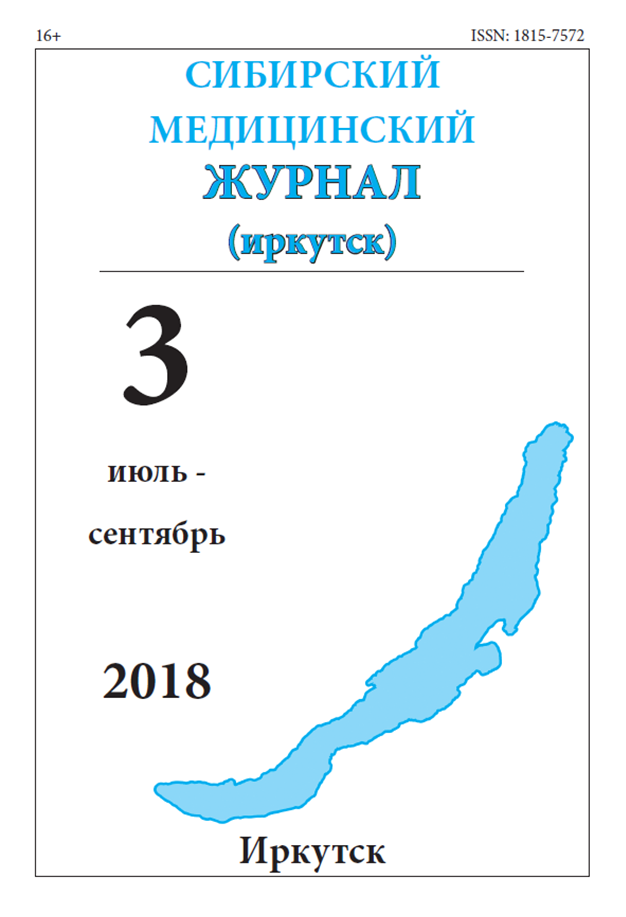ВЗАИМОСВЯЗЬ РЕЗУЛЬТАТОВ КОМПЬЮТЕРНОЙ ТОМОГРАФИИ СО ШКАЛОЙ КОМЫ ГЛАЗГО У ПОСТРАДАВШИХ С ОСТРОЙ ЧЕРЕПНО-МОЗГОВОЙ ТРАВМОЙ
Аннотация
Изучены результаты компьютерной томографии (КТ) 90 лиц с черепно-мозговой травмой (ЧМТ). Средний возраст пациентов составил 31,56±2,09 года. Мужчин было 88,9%, женщин – 11,1%.Тяжесть ЧМТ оценена с помощью шкалы комы Глазго (ШКГ). КТ проводилась по стандартной методике в обычном режиме без контрастирования. Основными причинами ЧМТ явились дорожно-транспортные происшествия (ДТП) (60,0%) и падения (32,2%). В 43,3% случаев диагностировалась легкая степень ЧМТ, средний балл ШКГ – 13,14±0,84. Средняя степень ЧМТ отмечалась в 44,4% случаев, средний балл – 9,2±1,28 и тяжелая степень ЧМТ – в 12,2% случаев, средний балл – 6,36±1,27. Смешанные поражения имеют более низкий показатель ШКГ (9,78±1,65), чем одиночные поражения (12,89±1,24). Наиболее низкие величины ШКГ имеют смешанные поражения в сочетании с переломами (6,42±1,03).
Литература
2. Киндаров З.Б., Идалов М.М., Умаров Р.М. и др. Сочетанная черепно-мозговая травма в Чеченской Республике: эпидемиология и исходы // Материалы Всероссийской научно-практической конференции «Поленовские чтения». СПб., 2007. С. 37- 38.
3. Китаев В.М., Китаев С.В. Лучевая диагностика заболеваний головного мозга. М.: МЕДпресс-информ. 2015. 136 с.
4. Овсянников Д.М., Чехонацкий А.А., Колесов В.Н., Бубашвили А.И. Социальные и эпидемиологические аспекты черепно-мозговой травмы (обзор) // Саратовский научно-медицинский журнал. 2012. Т. 8. № 3. С. 777–785.
5. Пономарева Е.Н., Сорокин А.А., Николайчик И.Р., Рухлядев И.С. и др. Легкая черепно-мозговая травма: структура и причины диагностических ошибок // Медицинские новости. 2011. №7. С.54-57.
6. Потапов А.А., Лихтерман Л.Б., Кравчук А.Д., Корниенко В.Н. и др. Современные подходы к изучению и лечению черепно-мозговой травмы // Анналы клинической и экспериментальной нефрологии. 2010. Т. 4. №1. С. 4-12.
7. Easter J.S., Haukoos J.S., Meehan W.P., Novack V., Edlow J.A. Will Neuroimaging Reveal a Severe Intracranial Injury in This Adult With Minor Head Trauma?: The Rational Clinical Examination Systematic Review // JAMA. 2015. Vol.314. №24. P. 2672-2681.
8. Hans P., Mehrotra A., Kumar P., Agarwal M., et al. Role of Computerized Tomography as Prime Imaging Modality in the Evaluation of Traumatic Brain Injury // Int J AdvInteg Med Sci. 2017. Vol.2 (1). P. 17-23.
9. Imtiaz A.M. Trauma Radiology: Importance of Computed Tomography Scans In Acute Traumatic Brain Injury // International Journal of Pharmaceutical Sciences and Business Management. 2016. Vol.4. Is. 4. P. 7-15.
10. Jagdish P., Chaturbhuj S., Naima M., Meena G.L., et al. Role of Computerized Tomography in Craniocerebral Trauma // Journal of medical science and clinical research (JMSCR). 2017. Vol. 5. Is. 3. P. 18540-18546.
11. Nayebaghayee H., Afsharian T. Correlation between Glasgow Coma Scale and brain computed tomography scan findings in head trauma patients // Asian J Neurosurg. 2016. Vol. 11. P. 46-49.
12. Sah S.K., Subedi N.D., Poudel K., Mallik M. Correlation of Computed Tomography findings with Glassgow Coma Scale in patients with acute traumatic brain injury // Journal of College of Medical Sciences-Nepal. 2014. Vol.10. No.2. P. 2-7.
13. Singh T.S., Bhargava A., Reddy N. Significance of computed tomography scans in head injury // Open Journal of Clinical Diagnostics. 2013. Vol. 3. P. 109-114.
14. Studel W.I., Cortbus F., Strowifzki M., et al. Epidemiology and prevention of total head injuries in Germany trends and the impact of the reunification // ActaNeutochirg. (Wein). 2005. Vol. 147. №3. P. 231- 242.
REFERENCES
1. Byvaltsev V.A., Kalinin A.A., Okoneshnikova A.K., Budayev A.E. Posttraumatic pneumacephalus: etiopathogenesis, diagnostics, methods of surgical treatment. // Acta Biomedica Scientifica. 2016. Vol. 1. № 4. P. 9-18. (in Russian)
2. Kindarov Z.B., Idalov M.M., Umarov R.M., et al. Concomitant traumatic brain injury in the Chechen Republic: epidemiology and outcomes Materials of the All-Russian scientific-practical conference "Polenskie readings". St. Petersburg, 2007. P. 37- 38. (in Russian)
3. Kitaev V.M., Kitaev S.V. Radiologic diagnosis of diseases of the brain. Moscow: MEDpress-inform, 2015. 136 p. (in Russian)
4. Ovsjannikov D.M., Chehonackij A.A., Kolesov V.N., Bubashvili A.I. Social and epidemiological aspects of traumatic brain injury (review) // Saratovskij nauchno-medicinskij zhurnal. 2012. Vol. 8. №3. P. 777–785. (in Russian)
5. Ponomareva E.N., Sorokin A.A., Nikolajchik I.R., et al. Easy traumatic brain injury: the structure and causes of diagnostic errors // Medicinskie novosti. 2011. №7. P. 54-57. (in Russian)
6. Potapov A.A., Lihterman L.B., Kravchuk A.D., al. Modern approaches to the study and treatment of traumatic brain injury // Annaly klinicheskoj i jeksperimental'noj nefrologii. 2010. Vol. 4. №1. P. 4-12. (in Russian)
7. Easter J.S., Haukoos J.S., Meehan W.P., Novack V., Edlow J.A. Will Neuroimaging Reveal a Severe Intracranial Injury in This Adult With Minor Head Trauma? The Rational Clinical Examination Systematic Review // JAMA. 2015. Vol.314. №24. P. 2672-2681.
8. Hans P., Mehrotra A., Kumar P., Agarwal M., et al. Role of Computerized Tomography as Prime Imaging Modality in the Evaluation of Traumatic Brain Injury // Int J AdvInteg Med Sci. 2017. Vol.2 (1). P. 17-23.
9. Imtiaz A.M. Trauma Radiology: Importance of Computed Tomography Scans In Acute Traumatic Brain Injury // International Journal of Pharmaceutical Sciences and Business Management. 2016. Vol.4. Is. 4. P. 7-15.
10. Jagdish P., Chaturbhuj S., Naima M., Meena G.L., et al. Role of Computerized Tomography in Craniocerebral Trauma // Journal of medical science and clinical research (JMSCR). 2017. Vol. 5. Is. 3. P. 18540-18546.
11. Nayebaghayee H., Afsharian T. Correlation between Glasgow Coma Scale and brain computed tomography scan findings in head trauma patients // Asian J Neurosurg. 2016. Vol. 11. P. 46-49.
12. Sah S.K., Subedi N.D., Poudel K., Mallik M. Correlation of Computed Tomography findings with Glassgow Coma Scale in patients with acute traumatic brain injury // Journal of College of Medical Sciences-Nepal. 2014. Vol.10. No.2. P. 2-7.
13. Singh T.S., Bhargava A., Reddy N. Significance of computed tomography scans in head injury // Open Journal of Clinical Diagnostics. 2013. Vol. 3. P. 109-114.
14. Studel W.I., Cortbus F., Strowifzki M., et al. Epidemiology and prevention of total head injuries in Germany trends and the impact of the reunification // ActaNeutochirg. (Wein). 2005. Vol. 147. №3. P. 231- 242.

Это произведение доступно по лицензии Creative Commons «Attribution-NonCommercial» («Атрибуция — Некоммерческое использование») 4.0 Всемирная.



